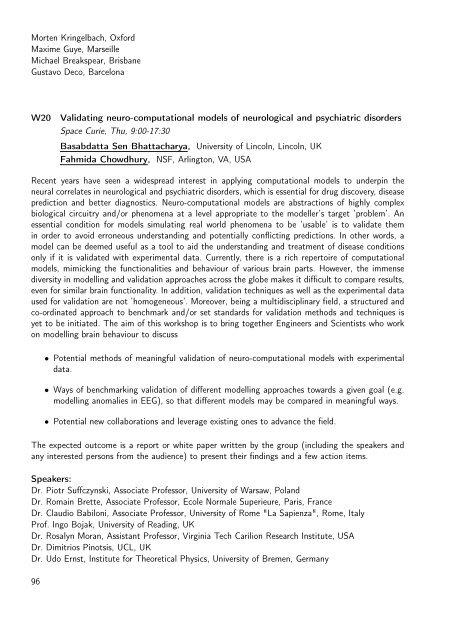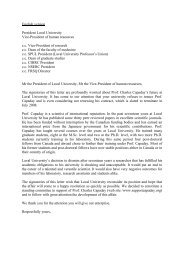Untitled - Laboratory of Neurophysics and Physiology
Untitled - Laboratory of Neurophysics and Physiology
Untitled - Laboratory of Neurophysics and Physiology
Create successful ePaper yourself
Turn your PDF publications into a flip-book with our unique Google optimized e-Paper software.
Morten Kringelbach, Oxford<br />
Maxime Guye, Marseille<br />
Michael Breakspear, Brisbane<br />
Gustavo Deco, Barcelona<br />
W20<br />
Validating neuro-computational models <strong>of</strong> neurological <strong>and</strong> psychiatric disorders<br />
Space Curie, Thu, 9:00-17:30<br />
Basabdatta Sen Bhattacharya, University <strong>of</strong> Lincoln, Lincoln, UK<br />
Fahmida Chowdhury, NSF, Arlington, VA, USA<br />
Recent years have seen a widespread interest in applying computational models to underpin the<br />
neural correlates in neurological <strong>and</strong> psychiatric disorders, which is essential for drug discovery, disease<br />
prediction <strong>and</strong> better diagnostics. Neuro-computational models are abstractions <strong>of</strong> highly complex<br />
biological circuitry <strong>and</strong>/or phenomena at a level appropriate to the modeller’s target ’problem’. An<br />
essential condition for models simulating real world phenomena to be ’usable’ is to validate them<br />
in order to avoid erroneous underst<strong>and</strong>ing <strong>and</strong> potentially conflicting predictions. In other words, a<br />
model can be deemed useful as a tool to aid the underst<strong>and</strong>ing <strong>and</strong> treatment <strong>of</strong> disease conditions<br />
only if it is validated with experimental data. Currently, there is a rich repertoire <strong>of</strong> computational<br />
models, mimicking the functionalities <strong>and</strong> behaviour <strong>of</strong> various brain parts. However, the immense<br />
diversity in modelling <strong>and</strong> validation approaches across the globe makes it difficult to compare results,<br />
even for similar brain functionality. In addition, validation techniques as well as the experimental data<br />
used for validation are not ’homogeneous’. Moreover, being a multidisciplinary field, a structured <strong>and</strong><br />
co-ordinated approach to benchmark <strong>and</strong>/or set st<strong>and</strong>ards for validation methods <strong>and</strong> techniques is<br />
yet to be initiated. The aim <strong>of</strong> this workshop is to bring together Engineers <strong>and</strong> Scientists who work<br />
on modelling brain behaviour to discuss<br />
• Potential methods <strong>of</strong> meaningful validation <strong>of</strong> neuro-computational models with experimental<br />
data.<br />
• Ways <strong>of</strong> benchmarking validation <strong>of</strong> different modelling approaches towards a given goal (e.g.<br />
modelling anomalies in EEG), so that different models may be compared in meaningful ways.<br />
• Potential new collaborations <strong>and</strong> leverage existing ones to advance the field.<br />
The expected outcome is a report or white paper written by the group (including the speakers <strong>and</strong><br />
any interested persons from the audience) to present their findings <strong>and</strong> a few action items.<br />
Speakers:<br />
Dr. Piotr Suffczynski, Associate Pr<strong>of</strong>essor, University <strong>of</strong> Warsaw, Pol<strong>and</strong><br />
Dr. Romain Brette, Associate Pr<strong>of</strong>essor, Ecole Normale Superieure, Paris, France<br />
Dr. Claudio Babiloni, Associate Pr<strong>of</strong>essor, University <strong>of</strong> Rome "La Sapienza", Rome, Italy<br />
Pr<strong>of</strong>. Ingo Bojak, University <strong>of</strong> Reading, UK<br />
Dr. Rosalyn Moran, Assistant Pr<strong>of</strong>essor, Virginia Tech Carilion Research Institute, USA<br />
Dr. Dimitrios Pinotsis, UCL, UK<br />
Dr. Udo Ernst, Institute for Theoretical Physics, University <strong>of</strong> Bremen, Germany<br />
96



